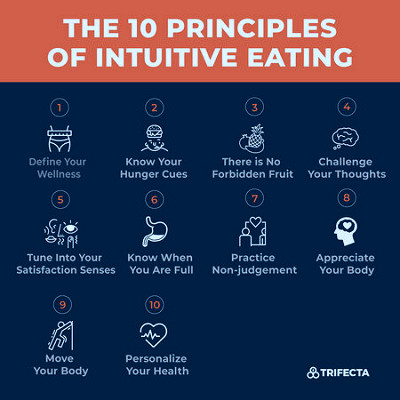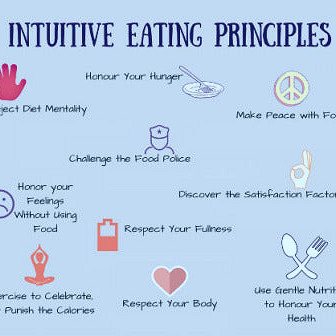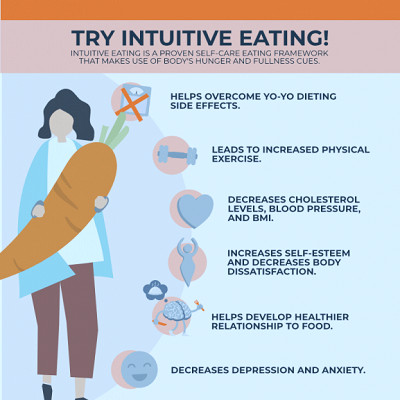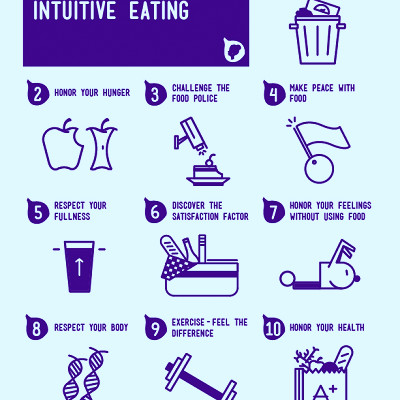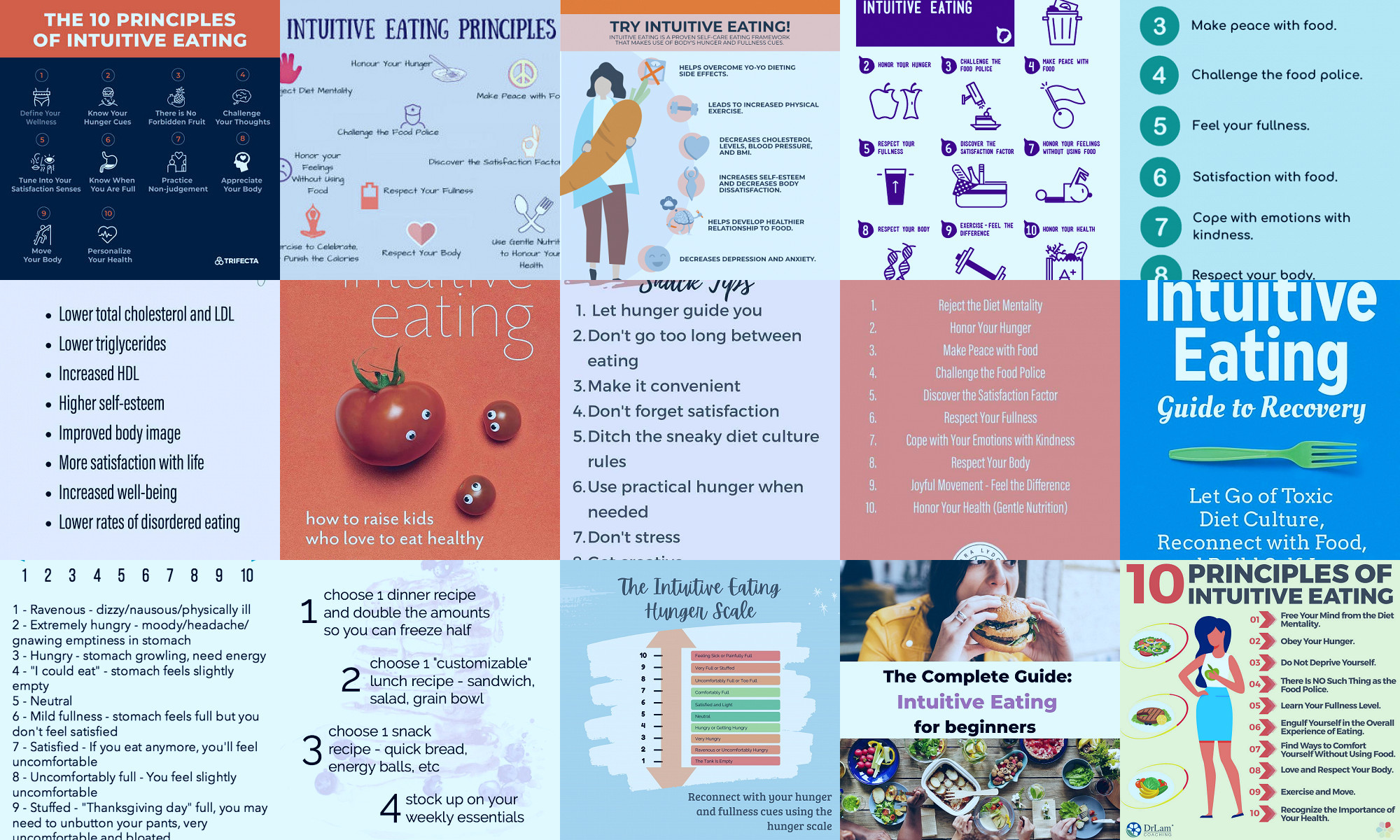 Jarlat Maletych/Shutterstock
Jarlat Maletych/Shutterstock
Features
Understanding Intuitive Eating
Intuitive eating is a nutrition philosophy based on the premise that becoming more attuned to the body's natural hunger signals is a more effective way to attain a healthy weight, rather than keeping track of the amounts of energy and fats in foods.
The Principle of Intuitive Eating
The key principle behind intuitive eating is to trust your body and its hunger cues. This involves eating when you feel hungry and stopping when you feel full, rejecting any diet mentality, and making peace with food.
The Connection Between Mind and Body
Intuitive eating is about making a deep connection with your body, understanding its needs, and responding appropriately. It encourages mindful eating, which involves savoring each bite, eating slowly, and enjoying meals free from distractions.
Rejecting the Diet Mentality
Intuitive eating challenges the dieting mindset that categorizes certain foods as 'good' or 'bad'. Instead, it promotes the acceptance of all foods, understanding that all types of food can fit into a balanced diet.
The Role of Hunger and Fullness Cues
Recognizing and responding to your body's hunger and fullness cues is a crucial aspect of intuitive eating. The idea is to eat when you're genuinely hungry, and to stop eating when you feel satisfied, not necessarily full.
Emotional Eating and Food Intuition
Emotional eating, or the tendency to eat in response to feelings rather than physical hunger, is discouraged in intuitive eating. The focus is instead shifted towards understanding the emotional triggers for eating and finding healthier coping mechanisms.
The Importance of Physical Activity
Regular physical activity is a cornerstone of intuitive eating. It's about moving your body in ways that feel good, rather than exercising simply to burn calories.
Practicing Self-Care
Intuitive eating goes beyond just food and exercise; it also encompasses overall wellness and self-care. This includes adequate sleep, stress management, and nurturing social connections.
Respect for Body Diversity
Intuitive eating acknowledges and respects body diversity. It promotes body positivity and encourages individuals to appreciate their unique bodies, rather than striving for an unrealistic ideal.
The Role of Nutrition
While intuitive eating promotes a balanced approach to all foods, it also recognizes the importance of nutrition. It encourages the consumption of a variety of foods that provide the nutrients your body needs to function well.
Challenging Food Police
In intuitive eating, there's no such thing as the 'food police'. You're encouraged to challenge the thoughts that label foods as 'good' or 'bad', and to enjoy all foods without guilt.
Coping with Emotional Triggers
Intuitive eating encourages you to explore different ways of coping with emotions, without using food. This could involve taking a walk, reading a book, or talking to a friend.
Satisfaction Factor
In intuitive eating, satisfaction is key. The goal is not just to eat, but to enjoy what you're eating. This can make the eating experience more enjoyable and prevent overeating.
Gentle Nutrition
The principle of gentle nutrition in intuitive eating encourages making food choices that honor both your health and your taste buds. It's about choosing foods that make you feel good, both physically and mentally.
Intuitive Eating and Health
Studies have shown that intuitive eating can lead to improved cholesterol levels, better body image, and increased satisfaction with life. It's also been associated with lower rates of disordered eating.
Intuitive Eating and Weight Management
Intuitive eating is not a weight loss diet, but a way of life. While some people might lose weight with intuitive eating, the focus is on health and well-being, not the scale.
Overcoming Food Fear
Intuitive eating aims to dismantle the fear around certain foods, helping you to have a healthier relationship with food overall.
Intuitive Eating as a Journey
The process of intuitive eating is a journey, not a destination. It's about learning, growing, and continually tuning into your body's signals.
Becoming an Intuitive Eater
Becoming an intuitive eater is a process that takes time. It involves learning to trust your body, let go of diet mentality, and making peace with food.
The Benefits of Intuitive Eating
Intuitive eating can lead to a healthier and happier relationship with food, improved mental health, greater body satisfaction, and overall better quality of life.
Interesting notes and facts
1. Embrace Hunger: Listen to Your BodyIntuitive eating begins with recognizing and honoring your hunger cues. This means learning to understand the physical signals your body sends when it's time to eat. This approach helps you identify real hunger from emotional hunger. By doing so, you'll be more attuned to your body's needs rather than mindlessly eating out of habit or boredom.
2. Nourish vs. Punish: Food as Fuel
Intuitive eating is about seeing food as a source of nourishment rather than a means of punishment or reward. This approach encourages you to make food choices that honor your health and taste buds while making you feel well. Remember, it's not about eating a perfect diet, but rather about making progress towards healthier choices.
3. Respect Your Fullness: Know When To Stop
Just as important as listening to your hunger is respecting your fullness. Intuitive eating encourages you to pay attention to the signals your body gives when it's no longer hungry. Slowing down, savoring each bite, and checking in with how your body feels can help you avoid overeating.
4. Experience Satisfaction: Enjoy Your Food
Eating should be a pleasurable experience. Intuitive eating emphasizes the importance of deriving pleasure from your food. This might mean choosing a food you really want rather than what you think you should eat, or taking the time to eat without distractions so you can truly savor your meal.
5. Food is Not The Enemy: No Food is Bad
In intuitive eating, there are no good or bad foods. This approach encourages you to let go of food guilt and instead make food choices based on what your body needs and wants. It's about eating a variety of foods that make you feel good physically and mentally.
6. Emotional Eating: Food is Not a Coping Mechanism
Intuitive eating recognizes that food can often be used as a coping mechanism for handling emotions. This approach encourages finding ways to cope with emotions without using food. This isn't about suppressing emotions, but rather finding healthy outlets for them.
7. Respect Your Body: Accept Your Genetic Blueprint
Intuitive eating is about respecting your body and accepting your genetic blueprint. This means understanding that everyone's body is unique, and what works for one person may not work for another. It's about embracing your body as it is, rather than striving for an unrealistic ideal.
8. Movement: Feel The Difference
Exercise is an important component of intuitive eating. But rather than focusing on how many calories you're burning, intuitive eating encourages you to focus on how movement makes you feel. This might mean choosing activities you enjoy rather than those you think you should do.
9. Self-Care: It's More Than Just Food
Intuitive eating is about more than just food. It's also about taking care of your overall well-being. This might mean ensuring you're getting enough sleep, managing stress, and taking time for self-care activities that make you feel good.
10. Patience is Key: It's a Journey, Not a Destination
Finally, intuitive eating is a journey, not a destination. It's about making sustainable changes to your relationship with food and your body that will last a lifetime. It takes patience and practice, but the rewards are well worth it.
Vocabulary
- Intuitive Eating – The practice of listening and responding to the body's natural hunger and satiety signals, rather than sticking to rigid diet rules.
- Holistic Health – An approach to well-being that considers the whole person, including physical, mental, and spiritual aspects.
- Homeopathy – A system of natural health care that treats each person as a unique individual with the aim of stimulating their own healing ability.
- Probiotics – Live bacteria and yeasts that are good for your health, especially your digestive system.
- Antioxidants – Compounds that protect your cells against the effects of free radicals, which can lead to chronic diseases.
- Organic – Foods or other materials produced without the use of synthetic pesticides or fertilizers.
- Superfoods – Foods that are nutrient-dense and considered to be especially beneficial for health and well-being.
- Veganism – The practice of abstaining from the use of animal products, particularly in diet.
- Nutrient Density – A measure of the amount of nutrients a food contains in comparison to the number of calories.
- Dietary Supplements – Products taken orally that contain a "dietary ingredient" intended to supplement the diet.
- Detoxification – The process of removing toxins from the body.
- Mindfulness – The practice of purposely focusing your attention on the present moment and accepting it without judgment.
- Yoga – A physical, mental, and spiritual practice that originated in ancient India.
- Meditation – A practice where an individual uses a technique to achieve a mentally clear and emotionally calm state.
- Aromatherapy – The use of aromatic plant extracts and essential oils for healing and cosmetic purposes.
- Herbal Medicine – The study of the use of plants to treat diseases and enhance general health and wellbeing.
- Naturopathy – A system of alternative medicine based on the theory that diseases can be successfully treated or prevented without the use of drugs.
- Vitamins – Organic compounds that are needed in small quantities to sustain life.
- Minerals – Solid, naturally occurring substances that are essential for the body's health and functioning.
- Omega-3 Fatty Acids – A type of fat that is crucial for brain health and is linked with lower levels of heart disease.
- Gluten-Free – A diet that excludes the protein gluten, which is found in grains such as wheat, barley, and rye.
- Paleo Diet – A dietary plan based on foods similar to what might have been eaten during the Paleolithic era.
- Ketogenic Diet – A low-carb, high-fat diet that can help burn fat more effectively.
- Plant-Based Diet – A diet consisting mostly or entirely of foods derived from plants, with few or no animal products.
- Raw Food Diet – A diet consisting of uncooked, unprocessed, and often organic foods.
- Fermented Foods – Foods that have been through a process of lactofermentation in which natural bacteria feed on the sugar and starch in the food creating lactic acid.
- Phytochemicals – Chemicals in plants that may affect health, but are not established as essential nutrients.
- Prebiotics – Non-digestible food ingredients that stimulate the growth and/or activity of bacteria in the digestive system.
- Alkaline Diet – A diet that emphasizes certain foods that can alter the acid-base balance of the body.
- Reflexology – A therapy involving application of pressure to the feet and hands with specific thumb, finger, and hand techniques.
- Chiropractic – A form of alternative medicine mostly concerned with the diagnosis and treatment of mechanical disorders of the musculoskeletal system.
- Reiki – A form of energy healing that originated in Japan.
- Acupuncture – A form of alternative medicine and a key component of traditional Chinese medicine in which thin needles are inserted into the body.
- Biofeedback – A technique you can use to learn to control some of your body's functions.
- Ayurveda – A holistic medicine system from India, focusing on maintaining a physical and emotional balance.
- Hydration – The process of making your body absorb water or other fluids.
- Exercise – Any bodily activity that enhances or maintains physical fitness and overall health and wellness.
- Sleep Hygiene – Practices and habits that are necessary to have good nighttime sleep quality and full daytime alertness.
- Stress Management – Techniques and psychotherapies aimed at controlling a person's level of stress.
- Essential Oils – Oils that capture the "essence" of the plant it was derived from, used often in aromatherapy.
- Tai Chi – An ancient Chinese tradition that today is practiced as a graceful form of exercise.
- Qi Gong – A holistic system of coordinated body posture, movement, breathing, and meditation used for health, spirituality, and martial arts training.
- Massage Therapy – The
